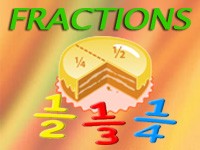Variables in the Denominator
Fraction problems get more difficult to solve when there is a variable in the denominator. To solve, find the least common denominator (LCD) of the fractions, and multiply both sides of the equation by it.
E X A M P L E :
Solve 
The LCD of  and
and  is
is  .
.



 (Answer)
(Answer)
Sometimes multiplying both sides of an equation by the LCD transforms the equation into an equation that is NOT equivalent to the original one. Multiplying both sides of an equation by a polynomial may introduce extraneous roots that do not satisfy the original equation. It is crucial to go back and check your answer in the original fractional equation.
E X A M P L E :
Solve 
Factor  into
into  . Now multiply both sides of the equation by the LCD of the fractions,
. Now multiply both sides of the equation by the LCD of the fractions,  .
.





 or
or  . (Answer)
. (Answer)
Because you multiplied both sides of the equation by a polynomial  , check to ensure the equation does not have extraneous roots. Substituting x = 0 into the original equation results in
, check to ensure the equation does not have extraneous roots. Substituting x = 0 into the original equation results in  or 1/5=1/5. Substituting x = 3 into the original equation results in 2/−2 = 2/−2 or −1 = −1. Both answers check, so they are not extraneous.
or 1/5=1/5. Substituting x = 3 into the original equation results in 2/−2 = 2/−2 or −1 = −1. Both answers check, so they are not extraneous.
Proportions are another type of problem that may have variables in the denominator. A proportion is an equation that sets two ratios (fractions) equal to each other. Don’t worry about finding least common denominators when solving a proportion, simply cross -multiply.
E X A M P L E :




 (Answer)
(Answer)

